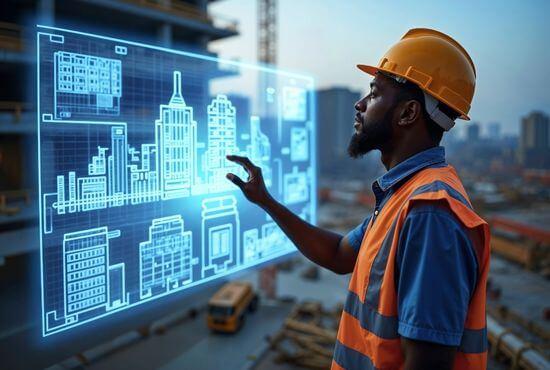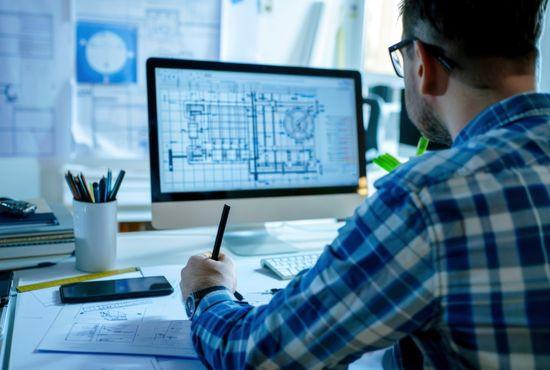Our industry will undergo something of a big bang by 2030 as we see the implementation of advanced technology in construction and simultaneously incorporate sustainable practice and data-driven approaches to construction into the marketplace. Essentially, construction and the construction industry are changing the way they design, build, and maintain infrastructure because of rapid urbanization and increased environmental hazards. In this article, we evaluate the most formational technologies, from advanced robotization and artificial intelligence (AI) to 3D printing and smart materials, that will shape the future of construction in our desire to maximize efficiency, sustainability, and resilience.
Construction is at the forefront of advanced technology in 2030, and it’s a total big bang of sustainability, innovative processes, and reliance on data. Construction technology and the challenges of accelerated urbanization and increased environmental risk are forcing the way we think about the design, building, and use of infrastructure around the world. This article examines the leading forming technologies that will shape the future of construction ranging from artificial intelligence and robotics to 3D printing and smart materials in terms of efficiency, sustainability, and resilience.
Also Read: 10 Best Construction Scheduling Software (Free & Paid)
The Imperative for Advanced Technology in Construction
Well, throughout history, the construction sector relied heavily on being labor-intensive and inefficient, now facing unprecedented demands in 2030. With the global population expected to be 8.5 billion and expanding rapidly urbanization the industry will need to deliver infrastructure execution at scale while reducing environmental impact. Advanced technology in construction faces the problem of streamlining workflows, bringing down costs, and promoting sustainability. It has been estimated by the industry that by 2030, the construction vertical will be worth more than $17 trillion, thus yielding a highly urgent call for the adoption of these game-changing technologies.

1. Artificial Intelligence and Machine Learning
This very advanced technology in construction applications belonging to the AI and ML domain perfectly fits into project planning, implementation, and maintenance specifically.
- AI for Predictive Project Management: AI platforms such as Construction IQ by Autodesk and Aconex by Oracle predict risks in the completion of a project with 90% accuracy. These risks include delays or cost overruns and are analyzed by the system on the basis of huge datasets amalgamating historical and real-time data. On their own, the systems use these data and suggest the correct scheduling; consequently, this has reduced project timelines by almost 20%.
- Generative Design: AI-powered generative design allows architects to feed in parameters concerning site constraints, budget, and sustainability margins, generating thousands of design options optimized in all these dimensions. For example, Zaha Hadid Architects has used generative design to develop energy-efficient skyscrapers that are cheap to construct with minimum amounts of materials.
- Safety and Compliance: AI-powered wearables track workers’ health with an above-average ability to detect fatigue or heat stress. On the other hand, computer vision systems check for compliance with defined safety protocols. These technologies have brought along a 25% reduction in accidents at work on mega-projects.
By 2030, AI circles will become omnipresent in advanced technology in construction, ensuring smarter decision-making and safer
2. Robotics and Automation
The combination of robotics and automation transforms complex work tasks and the construction industry recognizes advanced technology in construction as a critical element for reaching efficiency and precision goals.
- Autonomous Construction Equipment: Operates through GPS LiDAR and AI technologies to enable continuous operation of automated bulldozers excavators and cranes. The implementation of these technologies enables businesses to reduce their labor costs by approximately 30%. Large-scale projects now use Komatsu and Volvo fully autonomous vehicle fleets that function independently from human operators.
- Robotic Assembly: Robots like Hadrian X, a fully automated bricklaying robot, can build walls 10 times faster than crews, and with zero waste. The functionality is based on laser-guided precision measures to ensure the wall will remain structurally sound.
- Drones for Real-Time Monitoring: Drones equipped with 4K cameras and thermal imaging survey sites and inspections, monitor the construction process, and detect and record structural issues. By 2030, drone inspections are expected to save almost $10 billion or 20 percent, in annual inspection costs.
These robotic technologies, key components of advanced technology in construction, will help to eliminate human error and help to speed up project delivery.
3. 3D Printing and Additive Manufacturing

3D printing has become a real game-changer in the advanced technology sector of construction, allowing for quick, cheap, and sustainable building processes.
- Large-Scale 3D Printing: Apis Cor and ICON are enterprises that print full buildings in hours from concrete and composite materials. A 500-square-foot home worth less than $15,000 can now be printed to take care of housing shortages globally.
- 3D Printing Complex Geometry: 3D printing can assist architects in developing complex non-linear designs that cannot be achieved using the current building processes. For example, there is a 3D-printed office building in Dubai which captures the possibilities of the technology from an aesthetic standpoint.
- 3D Printed Sustainable Materials: Designers are innovating printable materials made of recycled plastics, or carbon-sequestering concrete, that have lower impacts on the environment with regard to construction. By 2030, 15% of new building projects will be expected to contain 3D-printed components.
It is easy to see why 3D printing is an essential part of advanced technology in construction, even more so for low-cost residential builds and disaster response.
4. Modular and Prefabricated Construction
The advancement of modular construction methods transforms building processes but needs advanced construction technology for speed improvement, cost reduction and environmental benefits.
- Factory-Based Assembly: Prefabricated components such as wall panels and MEP systems are produced inside controlled factories where waste decreases by 35% and construction duration shortens by 50%. A 40-story modular tower in Singapore reached completion within 18 months.
- Digital Integration: The integration of modular design with Building Information Modeling (BIM) requires advanced software to achieve precise on-site assembly. The process saves more than 20% in error-related rework expenses.
- Scalability for Urbanization: Modular methods help with urbanization when building high-density projects (schools, hospitals, residential complexes) where speed is important; these opportunities will unfold considerably in Asia and Africa.
Modular methods and building techniques are setting the pace for contemporary efficiency in construction while also offering more opportunities for sustainability through advanced technology in construction.
5. Sustainable Technologies and Green Building
Advanced technology receives substantial motivation from sustainability requirements that drive the construction industry to cut down its 40% contribution to global CO2 emissions.
- Net-Zero and Energy-Positive Buildings: Buildings achieve energy surplus through solar panels combined with geothermal heating and smart grid systems, which enable them to generate more power than their operational requirements. The Edge in Amsterdam functions as a net-zero office building which serves as an example.
- Bio-Based Materials: The construction industry now has access to new cross-laminated timber (CLT) and hempcrete options, which serve as low-carbon alternatives for concrete and steel. The carbon footprint of CLT stands at 50% lower than its alternative construction materials.
- Smart Building Systems: The Internet of Things (IoT) allows sensors to control lighting and HVAC systems and water systems so they adjust automatically depending on building occupancy and environmental conditions while saving energy. Smart energy systems lead to a 30% reduction in overall energy consumption when they are implemented.
The advanced technology in construction utilizes these green technologies as advanced tools which enable it to meet worldwide sustainability goals including the goal of reaching net-zero by 2050.
6. Augmented Reality (AR) and Virtual Reality (VR)
The advanced construction technology receives benefits from AR and VR through two functions which enable project visualization and team collaboration learning.
- Immersive Design: VR permits stakeholders to experience 3D models of buildings before any construction takes place thus limiting design errors by 15%. AR provides digital plans on a physical site to allow adjustments in real-time during construction.
- Worker Training: VR simulations train workers on complex tasks, such as operating autonomous machinery or installing prefabricated systems, to avoid safety hazards. Costs have been cut by 20% when using VR for training.
- Remote Collaboration: Teams across the world use AR and VR for virtual site tours which eliminate the need for both travel expenses and environmental pollution.
AR and VR adoption in advanced construction technology will experience a 40% growth by 2030 because these tools deliver better precision alongside improved teamwork.
7. Advanced Materials and Nanotechnology
Innovations in smart and sustainable materials are part and parcel of advanced technology for construction and will improve durability and environmental performance.
- Self-Healing Materials: Self-healing concrete, which is made with embedded bacteria or polymers, can self-repair cracks which will extend the lifespan of the structure by an additional 50 years and reduce maintenance costs.
- Nanomaterials: Concrete with graphene mixed into it has been reported to weigh less than traditional concrete and to be 30% stronger than traditional concrete. This improved merging of the past with the future allows builders to construct taller and more resilient structures. Nanomaterials will also reduce energy loss by 40% as insulation when in the form of aerogels.
- Transparent Aluminum: The material known as transparent aluminium serves as an advanced, lightweight, strong solution for windows and facades that delivers enhanced durability and thermal properties.
These advancements redefine construction technology by producing structures which possess enhanced strength alongside lighter weight and improved sustainability features.
8. Building Information Modeling (BIM) and Digital Twins
BIM and digital twins offer a completely new paradigm for how projects are designed, built and managed, an important aspect of advanced technology in construction.
- BIM for Integrated Design: BIM provides detailed 3D models of integrated architectural structural and MEP systems that are cleanly integrated into the overall delivery systems – reducing clashes and errors by more than 25% – while allowing owners and stakeholders feedback throughout the lifecycle of the project.
- Digital Twins for Real-Time Performance Management: Digital Twin takes this a step further by creating virtual replicas of physical assets, sharing IoT-based data and enabling owners and operators to utilize their most current building performance data. A specific example of this is Singapore’s digital twin of Marina Bay, where energy use and maintenance schedules are optimized in real-time.
- Lifecycle Optimization: Digital twins enable predictive maintenance by monitoring the physical assets for signs and symptoms of failures before repairs are required. Repair costs are therefore estimated to be reduced by as much as 15 – 20% in this way.
From a future perspective, BIM and digital twins will be the standard process for advanced technology in construction by 2030 allowing for a much more holistic approach to building management.
9. Internet of Things (IoT) and Smart Construction Sites
IoT is transforming construction sites into smarter and more efficient entities through technological advancements in construction.
- Connected Equipment: The use of IoT sensors allows construction machinery to monitor performance data, fuel consumption and predict maintenance needs, which has reduced downtime by up to 20%. For instance, Caterpillar uses IoT-enabled equipment to get fleet Operations.
- Smart Wearables: The development of wearable technology now tracks worker locations along with health statistics and hazard contact while these devices have decreased site injuries by 30% in certain situations.
- Environmental Monitoring: IoT sensors track air quality, noise levels and energy consumption on sites to maintain environmental compliance while reducing emissions.
Internet of Things (IoT) alters advanced technology applications in construction through the creation of data-focused responsive building sites that enhance both operational efficiency and safety protocols.
10. Adaptive Infrastructure and Resilient
Advanced construction technology will develop resilient structures because the worsening effects of climate change demand structures to adapt to harsh environmental conditions.
- Climate-Resilient Materials: The combination of wood and plastic together with fiber reinforced polymers and corrosion-resistant alloys will create construction materials that endure hurricanes flooding and earthquakes.
- Adaptive Urban Planning: – Through AI and IoT city planners will create adaptable urban environments that respond to rising sea levels and heatwaves. The implementation of permeable pavements together with green roofs and other items is expected.
- Retrofitting and Adaptive Reuse: Advanced technologies make retrofitting to energy-efficient systems a realistic task for older buildings and can allow older buildings to be modified for new uses while minimizing the impact of demolition and carbon emissions.
These resilient designs will reassure advanced construction technology that we are building infrastructure to thrive in a changing world.
Also Read: Top 10 Construction Companies in India You Should Know
Opportunities and Challenges
Advanced technology in construction industry shows great promise yet various obstacles remain. The initial expenses for deploying 3D printing and robotics in construction present a substantial barrier that prevents many small companies from embracing these technologies. The advanced construction regulations remain behind the technological progress, which generates obstacles to adopting new methods and technological innovations. Workers also need upskilling to be able to operate high-tech systems, with 60% of construction workers requiring training on using digital tools by 2030.
However, there are opportunities as well. The strong public-private partnerships which are leading investment in advanced technology in construction are exemplary of how public investment can take the immediate lead in funding current advanced technology, such as the smart infrastructure projects funded by the U.S. Infrastructure Investment and Jobs Act. Falling costs for technologies like 3D printing and AI will make technology investment more feasible, not to mention global sustainability targets, coupled with local mandates for net-zero carbon by 2030, are incentivising the adoption of technology.
The Future Beyond 2030
When looking beyond 2030, it is only going to get advanced technology in construction. 2040 is not far away, and fully autonomous construction sites powered by AI and robotics could be commonplace. There are even advancements in 4D printing, allowing for creations actually to adapt their form to their environment. Space-based construction technologies, such as 3D printing of lunar dwellings and habitats, are being developed by companies like SpaceX and NASA.
Conclusion
The construction industry will continue its transformation because of advanced technology which leads to better results through quicker and safer and environmentally friendly building approaches. The industry needs to adopt AI together with Robotics plus 3D/4D printing modular construction and innovative materials to address urbanization problems as well as climate change effects and resource limitations. The implementation of advanced construction technology enables us to develop new structures while creating a strong base for efficient, sustainable development. The built environment will undergo fundamental changes through these technologies during the period leading to 2030 and beyond because they will adapt to unpredictable world conditions.
FAQs on Advanced Technology in Construction
Q1. What are the biggest construction technologies in 2030?
A: AI project management and BIM 7D integration are two of the biggest transformations.”
Q2. Will construction jobs disappear due to automation?
A: No, they won’t disappear, they will evolve. They will require equally as many digital skills and technology sensibilities as traditional construction skills
Q3. Are these technologies available for small firms?
A: Yes, because of subscriptions, cloud platforms and growing competition, these technologies are becoming far more accessible.
Q4. Is 3D printing going to be feasible for mass scale construction work?
A: Yes. It is already being done in 2030, not just residential but commercial and infrastructure 3D printing is widespread with successful use cases globally.
Q5. How relevant is sustainability for construction in the future?
A: Very relevant. Sustainability tech and materials will be used as a key part of advanced technology in construction processes and strategies.



